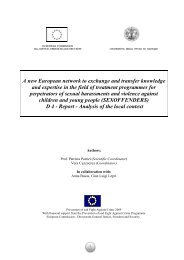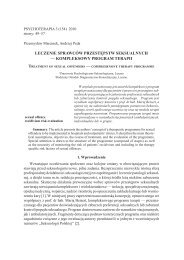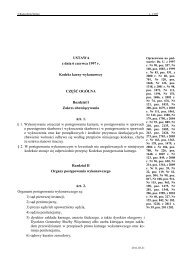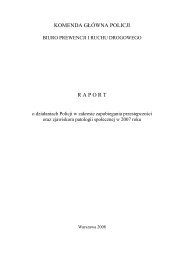ENGLISH
ENGLISH
ENGLISH
- No tags were found...
Create successful ePaper yourself
Turn your PDF publications into a flip-book with our unique Google optimized e-Paper software.
at high risk. Otherwise this exceedingly high number of cases could not be explained. The child protection authority in theirstatistic counted the number of cases where minors were involved, not the cases of violence against women.Of the 5 interviewed parties who are not using RAI in their agency, 3 stated that they do not know any: ‘There is no knowledgeabout them, either adapted to our language or to our working protocol.’Of the 5 respondents using a RAI, 2 are using a self-developed tool, i.e., a structured interview and an assessment tool forminor’s abuse 15 respectively.One respondent stated that they use the VPR Risk Prevention System and the VPER Risk Prevention Evaluation System 16 ,another indicated use of a joint assessment in the team and by other core agencies as a tool.Three respondents also said that they apply the RAI systematically. One respondent limited the application of RAI as follows:‘NO: when the victim refuses to denounce, it is not applied; YES: when an assessment of the aggressor is demanded.‘Concerning the helpfulness of RAI one responding party stated that ‘when victims refuse to denounce, when victims decideto rejoin with the aggressor‘ the tool was not helpful.The positive aspects of using RAI are mostly that ‘it permits to identify the situations and factors for risk. It helps the victimsto raise awareness about the risk.‘ Also, ‘it permits the professionals to design the protection plan in a more adequate andefficient way.‘A voice from the justice system: ‘Very useful to implement the protection measures by the police.‘Safety planningAll respondents stated that they have standards for protection and safety for high risk victims. But just 4 of them have writtenguidelines/policies.Seven out of 10 participants stated that setting up a safety plan is part of the standards. Additionally, two of them considerthe coordination with other core agencies for the protection plan and the permanent contact with the victim to be part of theirstandards.If the above-mentioned coordination is considered part of the multi-agency approach, then 5 named this as a standard forprotection and safety for high risk victims. The permanent contact to the victim is certainly one standard, but the question thatarises concerns the time frame of the term ‘permanent‘.Looking at the training on high risk cases in the participating organisations, 60% stated that their workers do not receive a regulartraining on this issue, and only 30% train the newcomers to their agency in this field. One respondent voiced a concern:‘Staff training is essential for our work, but mainly in Spanish, and it should be adapted to our usual working protocols.‘15wInterviewer’s note: „As part of the integrated treatment of the women victim of VAW, the IMRM (Instituto de la mujer de la region de Murcia) considered mention of the DGFM(Dirección General de Familia y Menor) relevant because they have a self-developed RAI which could be useful to detect risk situation for women, mothers of those minors.‘16Miguel Lorente, Government Delegate for Gender Violence, presented the balance of the Ministry of Equality on gender violence in the first half of 2010.P 53






